GOLD PREMIUM
HELLO? welcome to my store
thanks for visiting this page here you are guaranteed of well revised and assured EXAMS ALL GRADED A+ thus making your education journey easy and seamless .
DO NOT HESITATE TO CONTACT ME IF YOU ARE IN NEED OF ANY EXAM .I AM READY 24/7 TO ASSIST YOU
ALSO REFER YOUR FRIENDS.
- 14615
- 0
- 906
Community
- Volgers
- Volgend
104 Ontvangen beoordelingen
15558 items
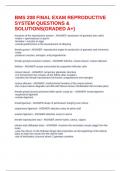
BMS 208 FINAL EXAM REPRODUCTIVE SYSTEM QUESTIONS & SOLUTIONS(GRADED A+)
functions of the reproductive system - ANSWER -production of gametes (sex cells) -males = spermatozoa or sperm -females = oocytes or eggs -overall goal/function is the development of offspring female gonad - ANSWER -reproductive organ for production of gametes and hormones -ovary -produces oocytes, estrogen, and progesterone female gonads (ovaries) contains - ANSWER follicles, corpus luteum, corpus albicans
- Tentamen (uitwerkingen)
- • 4 pagina's •
functions of the reproductive system - ANSWER -production of gametes (sex cells) -males = spermatozoa or sperm -females = oocytes or eggs -overall goal/function is the development of offspring female gonad - ANSWER -reproductive organ for production of gametes and hormones -ovary -produces oocytes, estrogen, and progesterone female gonads (ovaries) contains - ANSWER follicles, corpus luteum, corpus albicans

BMSC 208: RESPIRATORY I (MODULE 1) QUESTIONS & CORRECT SOLUTIONS
what are the 4 major functions of the respiratory system? - ANSWER 1. exchange of gases between the atmosphere and blood 2. homeostatic regulation of pH 3. protects body from inhaled pathogens and irritating substances 4. vocalization (movement of air along the pharynx) Air exchange occurs by? - ANSWER bulk flow what are the principles in which bulk flow flows through the CV system? - ANSWER 1. flow occurs from region of high pressure to low pressure 2. muscular pump creates the pres...
- Voordeelbundel
- Tentamen (uitwerkingen)
- • 11 pagina's •
what are the 4 major functions of the respiratory system? - ANSWER 1. exchange of gases between the atmosphere and blood 2. homeostatic regulation of pH 3. protects body from inhaled pathogens and irritating substances 4. vocalization (movement of air along the pharynx) Air exchange occurs by? - ANSWER bulk flow what are the principles in which bulk flow flows through the CV system? - ANSWER 1. flow occurs from region of high pressure to low pressure 2. muscular pump creates the pres...
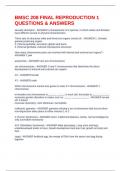
BMSC 208 FINAL REPRODUCTION 1 QUESTIONS & ANSWERS
sexually dimorphic - ANSWER a characteristic of a species, in which males and females have different sexual or physical characteristics Three sets of structures male and femal sex organs consist of: - ANSWER 1. Gonads: gamete producing organs 2. Internal genitalia: accessory glands and ducts 3. External genitalia: external reproductive structures How many chromosome pairs are involved with internal and external sex organs? - ANSWER 1 pair autosomes - ANSWER non-sex chromosomes sex...
- Voordeelbundel
- Tentamen (uitwerkingen)
- • 3 pagina's •
sexually dimorphic - ANSWER a characteristic of a species, in which males and females have different sexual or physical characteristics Three sets of structures male and femal sex organs consist of: - ANSWER 1. Gonads: gamete producing organs 2. Internal genitalia: accessory glands and ducts 3. External genitalia: external reproductive structures How many chromosome pairs are involved with internal and external sex organs? - ANSWER 1 pair autosomes - ANSWER non-sex chromosomes sex...

BMSC 208 - Module 2 QUESTIONS & CORRECT SOUTIONS(RATED A+)
Changes in PO2 and PCO2 during quiet respiration - ANSWER They are relatively constant during quiet respiration The effect of alterations of ventilation rate, independent of the CV system - ANSWER This will alter PO2 and PCO2, thus altering diffusion Local regional control for perfusion - ANSWER Gravity. There is more perfusion occurring at the bottom of the lungs (when upright)
- Voordeelbundel
- Tentamen (uitwerkingen)
- • 4 pagina's •
Changes in PO2 and PCO2 during quiet respiration - ANSWER They are relatively constant during quiet respiration The effect of alterations of ventilation rate, independent of the CV system - ANSWER This will alter PO2 and PCO2, thus altering diffusion Local regional control for perfusion - ANSWER Gravity. There is more perfusion occurring at the bottom of the lungs (when upright)
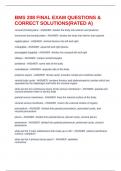
BMS 208 FINAL EXAM QUESTIONS & CORRECT SOLUTIONS(RATED A)
coronal (frontal) plane - ANSWER divides the body into anterior and posterior transverse (horizontal) plane - ANSWER divides the body into inferior and superior sagittal plane - ANSWER vertical division into left and right midsagittal - ANSWER equal left and right planes
- Tentamen (uitwerkingen)
- • 9 pagina's •
coronal (frontal) plane - ANSWER divides the body into anterior and posterior transverse (horizontal) plane - ANSWER divides the body into inferior and superior sagittal plane - ANSWER vertical division into left and right midsagittal - ANSWER equal left and right planes
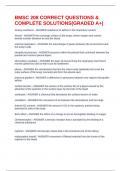
BMSC 208 CORRECT QUESTIONS & COMPLETE SOLUTIONS(GRADED A+)
Airway resistance - ANSWER resistance to airflow in the respiratory system Alveoli - ANSWER the exchange surface of the lungs, where oxygen and carbon dioxide transfer between air and the blood external respiration - ANSWER the interchange of gases between the environment and the body's cells intrapleural pressure - ANSWER pressure within the pleural fluid contained between the parietal and visceral pleural layers
- Voordeelbundel
- Tentamen (uitwerkingen)
- • 8 pagina's •
Airway resistance - ANSWER resistance to airflow in the respiratory system Alveoli - ANSWER the exchange surface of the lungs, where oxygen and carbon dioxide transfer between air and the blood external respiration - ANSWER the interchange of gases between the environment and the body's cells intrapleural pressure - ANSWER pressure within the pleural fluid contained between the parietal and visceral pleural layers
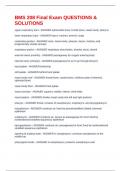
BMS 208 Final Exam QUESTIONS & SOLUTIONS
upper respiratory tract - ANSWER sphenoidal sinus, frontal sinus, nasal cavity, pharynx lower respiratory tract - ANSWER larynx, trachea, bronchi, lungs conducting portion - ANSWER nose, nasal cavity, pharynx, larynx, trachea, and progressively smaller airways respiratory portion - ANSWER respiratory bronchioles, alveolar ducts, alveoli external nares (nostrils) - ANSWER passageway
- Tentamen (uitwerkingen)
- • 11 pagina's •
upper respiratory tract - ANSWER sphenoidal sinus, frontal sinus, nasal cavity, pharynx lower respiratory tract - ANSWER larynx, trachea, bronchi, lungs conducting portion - ANSWER nose, nasal cavity, pharynx, larynx, trachea, and progressively smaller airways respiratory portion - ANSWER respiratory bronchioles, alveolar ducts, alveoli external nares (nostrils) - ANSWER passageway
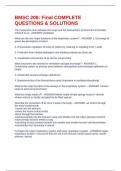
BMSC 208: Final COMPLETE QUESTIONS & SOLUTIONS
The movement of air between the lungs and the atmospheric environment is formally referred to as - ANSWER Ventilation What are the four major functions of the respiratory system? - ANSWER 1. Exchange of gases bw atmosphere & blood 2. Homeostatic regulation of body ph (either by retaining or expelling CO2 = acid) 3. Protection from inhaled pathogens and irritating substances (from air) 4. Vocalization (movement of air across vocal cords) What structures are involved in ventilation ...
- Voordeelbundel
- Tentamen (uitwerkingen)
- • 209 pagina's •
The movement of air between the lungs and the atmospheric environment is formally referred to as - ANSWER Ventilation What are the four major functions of the respiratory system? - ANSWER 1. Exchange of gases bw atmosphere & blood 2. Homeostatic regulation of body ph (either by retaining or expelling CO2 = acid) 3. Protection from inhaled pathogens and irritating substances (from air) 4. Vocalization (movement of air across vocal cords) What structures are involved in ventilation ...
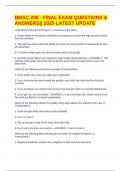
BMSC 208 - FINAL EXAM QUESTIONS & ANSWERS|| 2025 LATEST UPDATE
Least likely to be part of the form, or structure of the aorta: 1. Elastic fibres in the aorta's wall allow it to expand to receive the high pressure blood from the ventricle 2. The wall has many folds that divide the aorta into many small compartments to slow the blood flow 3. A smooth lining keeps the blood flowing easily and quickly 4. Smooth muscle fibres can contract to help modify blood pressure - ANSWER 2. The wall has many folds that divide the aorta into many small compar...
- Voordeelbundel
- Tentamen (uitwerkingen)
- • 15 pagina's •
Least likely to be part of the form, or structure of the aorta: 1. Elastic fibres in the aorta's wall allow it to expand to receive the high pressure blood from the ventricle 2. The wall has many folds that divide the aorta into many small compartments to slow the blood flow 3. A smooth lining keeps the blood flowing easily and quickly 4. Smooth muscle fibres can contract to help modify blood pressure - ANSWER 2. The wall has many folds that divide the aorta into many small compar...
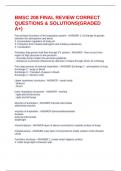
BMSC 208 FINAL REVIEW CORRECT QUESTIONS & SOLUTIONS(GRADED A+)
Four primary functions of the respiratory system - ANSWER 1. Exchange of gasses between the atmosphere and blood 2. Homeostatic regulation of body pH 3. Protection from inhaled pathogens and irritating substances 4. Vocalization Principles that govern bulk flow through CV system - ANSWER - flow occurs from region of high pressure to low pressure - muscular pump creates the pressure gradients - resistance is primarily influenced by diameter of tubes through which air is flowing Fou...
- Voordeelbundel
- Tentamen (uitwerkingen)
- • 22 pagina's •
Four primary functions of the respiratory system - ANSWER 1. Exchange of gasses between the atmosphere and blood 2. Homeostatic regulation of body pH 3. Protection from inhaled pathogens and irritating substances 4. Vocalization Principles that govern bulk flow through CV system - ANSWER - flow occurs from region of high pressure to low pressure - muscular pump creates the pressure gradients - resistance is primarily influenced by diameter of tubes through which air is flowing Fou...

ALTA Exam - Standard 4 Knowledge of Testing terms(GRADED A+)
LSUS Chen- MBA 706 Module 4 100% Accurate
EVEXAM24 - 2025 EV EXPERT EXAM 100% Accurate
EVEXAM24 - 2025 EV EXPERT EXAM 100% Accurate
NC Post Licensing 301 Practice Exam 1 88/100 Correct 100%